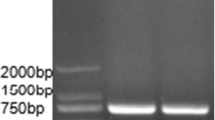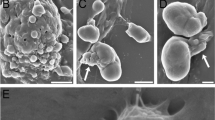Abstract
Three in vitro studies were designed to develop an assay for anticoccidial efficacy by use of laboratory (Houghton) and field (T-376) Eimeria tenella strains. In study (1), minimum inhibitory concentrations (MICs) of monensin (Mon), maduramicin (Mad), salinomycin (Sal), and lasalocid (Las) were determined that are able to inhibit more than 50 % of sporozoites in host cell (Madin-Darby bovine kidney (MDBK)) penetration and more than 95 % of Houghton sporozoites development to mature merozoites (treatment time 24 h) using quantitative real-time PCR (qPCR). MICs were 0.5, 2.5, 1, and 0.5 μg/ml for Mon, Mad, Sal, and Las, respectively. Applying the previous MIC on T-376 strain revealed a different sensitivity profile. Mad reduced T-376 gene copies by only 89.3 % after 96 h of infection. In study (2), Houghton strain sporozoites were incubated with MIC of the different tested ionophores for 2 and 4 h, respectively; afterwards, their ability to invade MDBK cells was determined using phase-contrast microscopy and qPCR. Treatment of sporozoites with ionophores for 4 h resulted in significant inhibition of invasion compared with non-treated parasites as assessed both by microscopy as well as qPCR. Inhibition rates for Mon, Mad, Sal, and Las were 90.2, 75.0, 88.3, and 82.6 % using phase-contrast microscopy and 83.9, 81.4, 85.8, and 75.4 % using qPCR, respectively. T-376 sporozoite invasion into MDBK cells was reduced to 48.9 % by Mad. Study (3) was conducted to determine inhibition exerted by toltrazuril (Tol). Tol at 5 μg/ml reduced reproduction of Houghton strain by 95 %, whereas T-376 was only reduced by 86.5 %. The presented experiments indicate that infectivity inhibition of sporozoites incubated for 4 h with anticoccidials and development inhibition after 96 h of infection by qPCR are suitable means to assess sensitivity of E. tenella strains to anticoccidials.






Similar content being viewed by others
References
Abbas R, Iqbal Z, Blake D, Khan M, Saleemi M (2011) Anticoccidial drug resistance in fowl coccidian: the state of play revisited. World Poult Sci J 67:337–350
Allen P, Fetterer R (2002) Recent advances in biology and immunobiology of Eimeria species and in diagnosis and control of infection with these coccidian parasites of poultry. Clin Microbiol Rev 15:58–65
Chapman H (1998) Evaluation of the efficacy of anticoccidial drugs against Eimeria species in the fowl. Int J Parasitol 28:1141–1144
Haberkorn A, Stoltefuss J (1987) Studies on the activity spectrum of toltrazuril, a new anti-coccidial agent. Vet Med Rev 1:22–32
Jenkins M, O’brien C, Fuller L, Mathis G, Fetterer R (2014) A rapid method for determining salinomycin and monensin sensitivity in Eimeria tenella. Vet Parasitol S0304–4017(14):00502-0. doi:10.1016/j.vetpar.2014.09.017
Johnson J, Reid W (1970) Anticoccidial drugs: lesion scoring techniques in battery and floor-pen experiments with chickens. Exp Parasitol 28:30–36
Kawahara F, Taira K, Nagai S, Onaga H, Onuma M, Nunoya T (2008) Detection of five avian Eimeria species by species-specific real-time polymerase chain reaction assay. Avian Dis 52:652–656
Köstelbauer A, Teichmann K, Henikl S, Schatzmayr G (2011) A flow cytometric invasion inhibition assay for the screening of anti-eimerial phytogenics. Animal hygiene and sustainable livestock production. Proceedings of the XVth International Congress of the International Society for Animal Hygiene, Vienna, Austria, 3-7 July 2011, volume 3, pp 1295–1297
Mattiello R, Boviez J, McDougald L (2000) Eimeria brunette and E. necatrix in chickens of Argentina and confirmation of seven species of Eimeria. Avian Dis 44:711–714
McDougald L (1982) Chemotherapy of coccidiosis (Chapter 9). In: Long P (ed) The biology of the coccidiosis. University Park Press, Baltimore, pp 373–427
McDougald L (1990) Control of coccidiosis: chemotherapy. In: Long P (ed) Coccidiosis of man and domestic animals. CRC Press, Boca Raton, pp 307–320
McDougald L, Fitz-Coy S (2013) Coccidiosis: protozoal infections. In: Swayne DE (ed) Diseases of poultry, 13th edn. Blackwell, New York, pp 1148–1166
McDougald L, Galloway R (1976) Anticoccidial drugs: effects on infectivity and survival intracellularly of Eimeria tenella sporozoites. Exp Parasitol 40:314–319
McDougald L, Fuller L, Mattiello R (1997) A survey of coccidian on 43 poultry farms in Argentina. Avian Dis 41:923–929
Mehlhorn H, Pooch H, Raether W (1983) The action of polyether ionophorous antibiotics (monensin, salinomycin, lasalocid) on developmental stages of Eimeria tenella (Coccidia, Sporozoa) in vivo and in vitro: study by light and electron microscopy. Z Parasitenkd 69:457–471
Mosmann T (1983) Rapid colorimetric assay for cellular growth and survival: application to proliferation and cytotoxicity assays. J Immunol Methods 65:55–63
Peek H, Landman W (2003) Resistance to anticoccidial drugs of Dutch avian Eimeria spp. field isolates originating from 1996, 1999, 2001. Avian Pathol 32:391–401
Pierce M (1980) A simple staining technique to demonstrate the sporozoite refractile globule in coccidian parasites. Parasitology 80:551–554
Raether W, Hofmann J, Uphoff M (1995) In vitro cultivation of avian Eimeria species: Eimeria tenella. In: Eckert J, Braun R, Shirley MW, Coudert P (eds) Biotechnology guidelines on techniques in coccidiosis. European Commission, Brussels, pp 79–92
Reed P (1982) Biochemichal and biological effects of carboxylic acid ionophores. In: Westley JW (ed) Polyether antibiotics. Marcel Dekker, New York, pp 185–302
Rochelle P, Marshall M, Mead J, Johnson A, Korich D, Rosen J, De Leon R (2002) Comparison of in vitro cell culture and a mouse assay for measuring infectivity of Cryptosporidium parvum. Appl Environ Microbiol 68:3809–3817
Schmatz D, Crane M, Murray P (1984) Purification of Eimeria sporozoites by DE-52 anion exchange chromatography. J Protozool 31:181–183
Schmatz D, Crane M, Murray P (1986) Eimeria tenella: parasite-specific incorporation of 3H-uracil as a quantitative measure of intracellular development. J Protozool 33:109–114
Shirley M (1977) Development of some species and strains of Eimeria from single sporozoites and sporocyst. J Parasitol 24:A43–A44
Smith C, Galloway R, White S (1981) Effect of ionophores on survival, penetration, and development of Eimeria tenella sporozoites in vitro. J Parasitol 67:511–516
Stephan B, Rommel M, Daugschies A, Haberkorn A (1997) Studies of resistance to anticoccidial in Eimeria field isolates and pure Eimeria strains. Vet Parasitol 69:19–29
Tierney J, Mulcahy G (2003) Comparative development of Eimeria tenella (Apicomplexa) in host cell in vitro. Parasitol Res 90:301–304
Vázquez F, Vázquez R (1990) Toltrazuril: a new anticoccidial drug against all species of coccidia. In: Proceedings of the 39th Western Poultry Disease Conference, Sacramento, CA, pp 74–75
Wang Z, Suo X, **a X, Shen J (2006) Influence of monensin on cation influx and Na+-K+-ATPase activity of Eimeria tenella sporozoites in vitro. J Parasitol 92:1092–1096
Zhang J, Wilson E, Yang S, Healey M (1996) Increasing the yield of Eimeria tenella oocysts in primary chicken kidney cells. Avian Dis 40:63–67
Zhu G, McDougald L (1992) Characterization in vitro and in vivo of resistance to ionophores in a strain of Eimeria tenella. J Parasitol 78:1067–1073
Author information
Authors and Affiliations
Corresponding author
Rights and permissions
About this article
Cite this article
Thabet, A., Alnassan, A.A., Daugschies, A. et al. Combination of cell culture and qPCR to assess the efficacy of different anticoccidials on Eimeria tenella sporozoites. Parasitol Res 114, 2155–2163 (2015). https://doi.org/10.1007/s00436-015-4404-4
Received:
Accepted:
Published:
Issue Date:
DOI: https://doi.org/10.1007/s00436-015-4404-4




